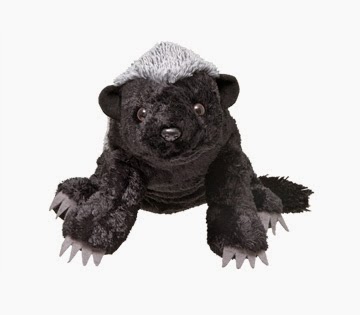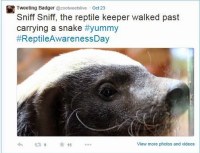
Meet Badger. She represents the zoo spokes-animal of the future: wi-fi enabled, web-connected, capable of understanding spoken language and powered by a Siri-like artificial intelligence. Also cute and fluffy.
 |
| Plush Badger From World Wildlife Fund’sSpecies Adoption Center Not (yet) Wi-Fi enabled, etc. |
Why do zoos need Badger? To actively campaign for the hearts and minds of the next generation of potential zoo-goers—because we can’t assume that people in general believe that zoos are forces for good. They may instead lump nonprofit living collections with companies like Sea World, which (as I explored in TrendsWatch 2015) is suffering a big loss in visitation due to viral protests over the exploitation of Killer Whales.
James Heaton, president of the marketing firm Tronvig Group, recently blogged about this challenge, recounting the conflicted attitudes of his teenage daughter and pre-teen son. The fourteen-year-old, though a confirmed zoo lover, still thinks that zoos are bad “because they treat the animals poorly.” The eleven-year-old says “I don’t like the idea of animals being held in cages.” Such attitudes are shaped in part by campaigns (like the anti-SeaWorld #BlackFish) by animal rights activists, and as Heaton observes “If my children are any indication, the anti-zoo brand is doing a damn good job.” On the other hand, research suggests that zoos aren’t doing a great job emphasizing their conservation credentials in order to control the dialog and shape public opinion. We need to forge relationships with the Next Gen zoo goer so that they are not only fond of zoos (as are Heaton’s children) but also know what zoos are doing to help the species they care for.
Hence: Badger. As any parent knows, the way to a child’s heart is through his/her favorite plushie. What if that plushie spoke on behalf of the zoo, and on behalf of her species?
The technology needed to make this happen already exists. Dolls have “talked” for decades. The problem with Chatty Cathy and her kin was that what they had to say wasn’t that interesting (“Want to play house?”) and they said it over and over again. Mattel is about to transcend that limitation by introducing Hello Barbie, a Wi-Fi connected version of the venerable doll equipped with speech recognition and thousands of potential responses. And as the algorithms powering Barbie “learn” from interacting with a child, they adapt and personalize her responses. The director of the Children’s Digital Media Center at Georgetown University opines, in a recent NYT article, that “toys able to personalize their responses to children in real time could be cutting-edge facilitators of learning,” but they raise concerns as well. Do the recordings collected via Hello Barbie constitute “spying” on kids? Will Mattel use Barbie’s data to feed children targeted advertising? If only these smart toys and the data they collect were managed by a trusted organization. If only they provided something meaningful to learn. Oh, hey, that’s where zoos come in!
 The Johannesburg Zoo in South Africa has already drafted one of its live animals as resident spokespecimen. Staff wired up the enclosure of BG the Honey Badger with a variety of sensors, each programmed to trigger related content, and fed the results into a Twitter account (@ZooTweetsLive) that has over ten thousand followers and a Klout score of 43. (Klout’s a measure of social media influence: The average score is about 40, so Honey Badger’s doing pretty good!)
The Johannesburg Zoo in South Africa has already drafted one of its live animals as resident spokespecimen. Staff wired up the enclosure of BG the Honey Badger with a variety of sensors, each programmed to trigger related content, and fed the results into a Twitter account (@ZooTweetsLive) that has over ten thousand followers and a Klout score of 43. (Klout’s a measure of social media influence: The average score is about 40, so Honey Badger’s doing pretty good!) The Zoo considers the “world’s first live tweeting badger” to be a huge success in terms of ROI for a social media campaign. I see her as one step along the path of creating sustained, personalized engagement with young visitors.
Here’s my proposal: cross Hello Barbie with BG the Tweeting Badger. What if children could buy a plushie of their favorite zoo animal, one that served as a responsive, engaging avatar, relays what’s going on with the live animal at the zoo? (“Hello! I did 4 laps around the badger sett today! Do you want to go for a run?”) Or talks about scientists helping her cousins in the wild? (“Hey, this radio collar tickles.”) I bet equipping plushies to speak on behalf of the species they represent would foster awareness, empathy and repeat visitation.
When I spoke to attendees at the Museum Store Association last year, I made the case for keepingstores in-house rather than outsourcing to big contractors. For one thing, integrating the store into museum operations makes it easier to create and market products that support the work of the organization in many ways. Personalized, mission-driven products like Badger are more likely to arise from teams working within our organizations, across departments, than from vendors focused solely on their cash ROI. And really, wouldn’t it be great if any museum could send visitors home with an interactive representative? Hmm, I wonder if Mattel is planning a “Hello” version of Paleontologist Barbie—maybe natural history museums can get in on the act, too.









The only problem with Hello Paleontologist Barbie is that some judicious censorship of her comments may be in order, especially at the end of the day.
One step towards Stephenson's Diamond Age? http://en.wikipedia.org/wiki/The_Diamond_Age
KayBee–absolutely! Museums ought to harness cognitive computing to provide "museum tutors" for every curious child. 🙂